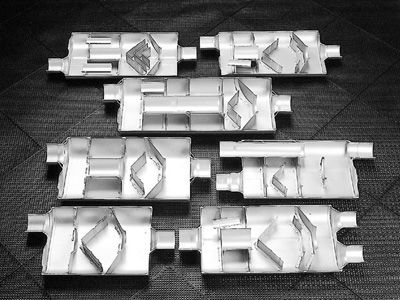
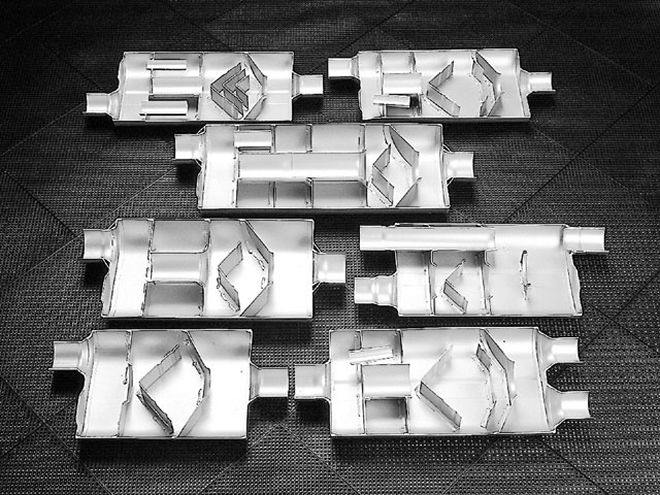
Zoning regulations rarely fall in favor of the racer. As suburban areas take up space, these areas are running right up against the boundaries of long-established racing facilities. The fact that the racers were there first matters little when new, more restrictive zoning ordinances are passed. The only option for track operators and racers in many cases is to quiet down or shut down
Fortunately, as long as the ordinance is reasonable, it isn't all that hard to do. The most common maximum noise level agreed upon is 95 to 100 decibels at 100 feet. For a V-8 race car, that isn't hard to exceed under full throttle, but with the proper muffler installed, you can get under those limits without killing your power. The key is to minimize backpressure, which can harm the efficient flow of air and fuel into the combustion chambers.
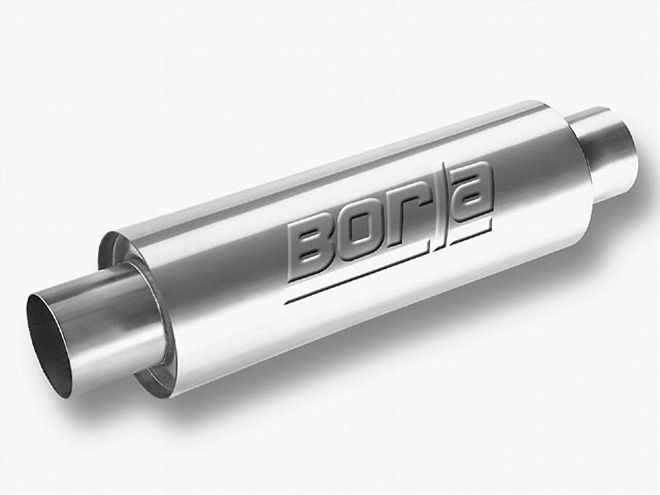
Backpressure is created when a muffler (or anything else) impedes the flow of the burnt air/fuel gasses out of the exhaust pipe. For this story, though, we will consider only the role of the muffler. A restrictive muffler creates higher pressure in the exhaust pipes from the muffler inlet all the way to the exhaust valve. A naturally aspirated engine moves air and fuel through the system by taking advantage of the atmosphere's tendency to flow from high-pressure areas to low, so this increase in pressure in the exhaust path reduces the amount of burnt gasses that can flow from the combustion chamber into the exhaust plumbing. You can see where this is leading-a combustion chamber that isn't completely evacuated means there is less room for the incoming air/fuel charge, and because the already burnt by-products of combustion don't tend to burn a second time, overall engine performance is lowered.
For many of us, running an unmuffled exhaust system is no longer an option, but that doesn't mean you have to live with tons of backpressure clogging your engine. Modern muffler designs specific for racing can achieve good results when it comes to reducing noise levels without harming power levels. The key is that the greatest part of an engine's noise is created not by the "explosion" caused by burning fuel in the combustion chamber, but by the pressure wave created when the exhaust valve first opens and high-pressure exhaust gasses come rushing out at supersonic speeds. This is why a high-compression racing engine sounds louder than an unmuffled street engine. If the energy in those waves can be reduced before they reach the open atmosphere-either by disrupting them or splitting them into smaller waves-the quality of the sound can be changed or even reduced.
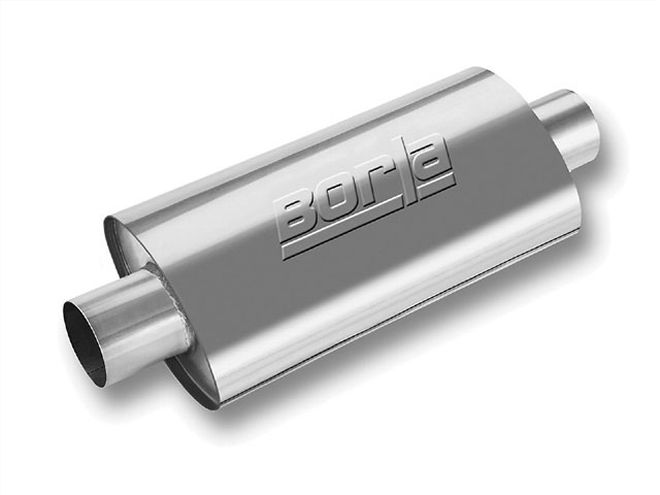
Currently, muffler designs can be broken down into two categories, depending on how they go about dampening the pressure waves that create sound. The most common design is probably the baffled muffler. This uses a series of pipes or dams that force the exhaust gasses through a tortuous route through the muffler casing before exit. These turns force the pressure waves to bend and bounce off each other, which dissipates each wave's energy.
The second design is commonly referred to as a straight pipe, which means there are no obstructions in the flow path. A straight-pipe muffler reduces noise by using a perforated tube, and in some cases a packing material around that, to absorb and break up the pressure waves as they travel through the muffler. The concept is similar to that of adding carpet and heavy curtains to a room to make it a "quieter" environment.
Both designs are effective if the muffler is properly built and matches the engine's needs, and neither has a clear-cut advantage over the other. If you aren't required to run a spec muffler, several companies have good muffler options to best fit your needs.
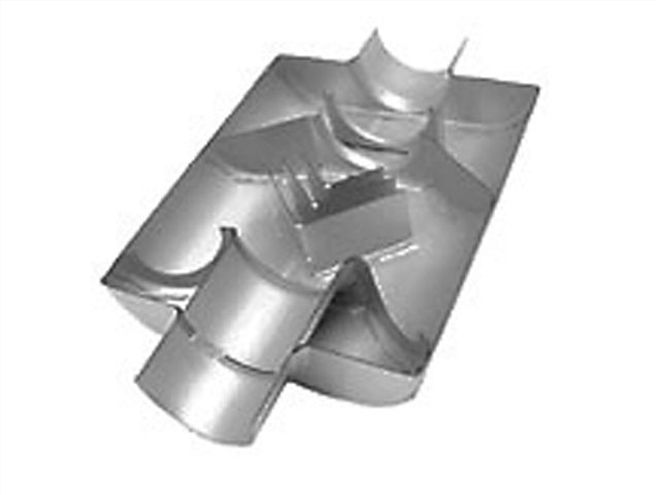 Flowmaster's mufflers use a baffled design to dissipate each pressure wave's energy before it exits the exhaust pipe.
Flowmaster's mufflers use a baffled design to dissipate each pressure wave's energy before it exits the exhaust pipe.
Borla Performance Industries In racing circles, Borla is famous for its straight-pipe designs, which are popular in Dirt Late Model racing where big-inch engines require a lot of flow. Borla also stresses that it's as important to maintain exhaust gas velocity as it is to maintain flow because the velocity of the exhaust pulse is what helps create the scavenge effect in the combustion chamber. It's for this reason that the mufflers are designed to provide maximum flow characteristics with smaller diameter tubing. Borla offers a host of options in every size and length imaginable. Simply give Borla's tech department a call to determine what will work best with your engine.
Flowmaster Flowmaster mufflers use the baffled design to disrupt the sound-producing pressure waves before they exit your exhaust system. Like water rushing past a rock in a stream, the baffles produce low-pressure areas in the lee of the exhaust flow, which deaden sound. Flowmaster's line of racing mufflers is designed to maximize the scavenging effect while minimizing the overall package size of the muffler so that it can easily be placed in the best location under your race car.
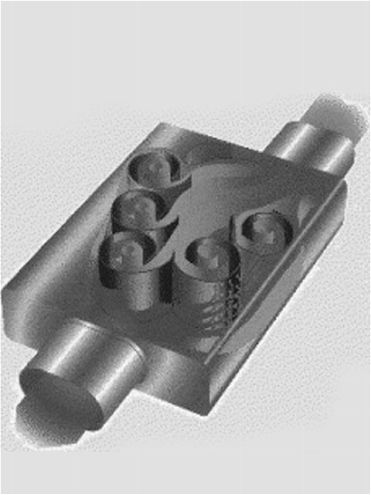 This cutaway shows Spin Tech's unique muffler design, which forces the exhaust gasses into vortices that "trap" the noise.
This cutaway shows Spin Tech's unique muffler design, which forces the exhaust gasses into vortices that "trap" the noise.
Schoenfeld Headers Famous for their headers for years, Schoenfeld also produces a line of mufflers specifically for racers. Constructed from mild steel and economically priced, Schoenfeld's mufflers utilize the straight-pipe design without packing material for minimum weight, size, and cost. If you race IMCA, SUPR, All-Stars, WoO, or any of several other sanctions, Schoenfeld produces mufflers specific to your rule book. Also, if your rule book requires only a muffler without stating noise limits, Schoenfeld produces a lightweight muffler insert that fits in your header's collector and produces limited damage to your power and your checkbook.
Spin Tech Spin Tech uses a unique baffled design to "spin" the exhaust gasses into several high-velocity vortices, which are said to "trap" the sound waves. This is accomplished with several specially designed tubes welded into place inside the muffler. Spin Tech says the effect is essentially to turn the sound into heat and radiate it out through the muffler case. The vortices are also said to create low-pressure systems inside the case, which improve combustion chamber scavenging.
Engine Tuning for Mufflers
Obviously, every situation is different, but here are a few guidelines for engine tuning when adding mufflers to the exhaust system.
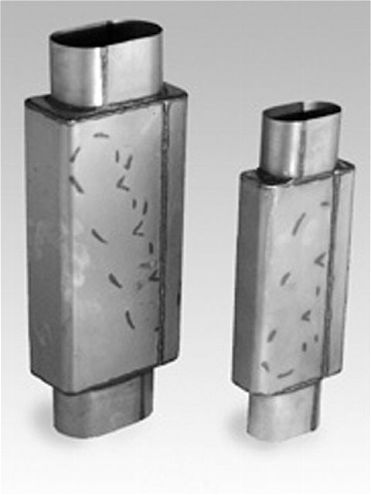 Although it has recently begun producing street mufflers, Spin Tech's bread-and-butter is racing. It has several designs available depending on the class you are racing and the decibel levels you are required to meet.
Although it has recently begun producing street mufflers, Spin Tech's bread-and-butter is racing. It has several designs available depending on the class you are racing and the decibel levels you are required to meet.
Although it's advantageous in any situation, make sure you run a crossover pipe between the exhaust pipes before the mufflers. This helps equalize pressure between the cylinder banks, which can help with pulse dampening and reduce noise even without a muffler. Of course, a crossover pipe increases scavenging and helps power, so you should be running one anyway. Both X- and H-pipe designs work well.
Here's an obvious one for you: Don't overmuffle. If your rule book states specific decibel limits at a specific distance, find a muffler that meets that requirement with your engine without going over. Don't make yourself work harder than you have to.
If you are forced to use a spec muffler that increases backpressure, keep an eye on your coolant and oil temps. Backpressure not only reduces exhaust gas flow out of the combustion chambers, but also causes the engine to retain more heat.
Backpressure harms an engine's fuel economy. Also, additional jetting in the carburetor may be required to regain a measure of lost performance.
If you have a muffler that adds to backpressure, you may be required to make a cam change to restore some of the lost power. Typically, you will need to shorten the valve overlap.
Don't end the exhaust circuit at the muffler. In most cases, a length of exhaust pipe after the muffler will increase power and sound dampening.
Finally, if you are running a Street Stock on another low-power class, your engine's limited exhaust flow means you probably don't need a full-out racing muffler. If money is an issue, a race muffler may provide no benefit over a performance street muffler. Try one out and see, or ask your engine builder.